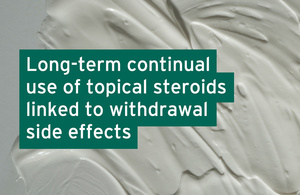Long-term continual use of topical steroids linked to skin withdrawal side effects
The Medicines and Healthcare products Regulatory Agency (MHRA) is advising anyone experiencing skin redness or burning sensations after they have stopped using these creams or ointments to seek advice from their health professional before using these products again.

Topical steroids
Patients using topical corticosteroid creams to treat conditions such as eczema or psoriasis are reminded to do so in accordance with advice from their healthcare professional, after a national review found that people using topical steroid for long-periods of time can suffer severe skin withdrawal symptoms.
Although this is very infrequent reaction, the Medicines and Healthcare products Regulatory Agency (MHRA) is advising anyone experiencing skin redness or burning sensations after they have stopped using these creams or ointments to seek advice from their health professional before using these products again.
Topical corticosteroids are medicines applied directly to the skin to treat conditions such as eczema or psoriasis. Patients can experience topical steroid withdrawal reactions after using these products at least daily for long periods of time. It is not unusual for skin conditions to flare up or return shortly after stopping topical corticosteroids. However, very infrequently, a severe type of topical steroid withdrawal reaction can occur, which may also be known as red skin syndrome or topical steroid addiction.
Signs of severe topical steroid withdrawal reactions include redness of the skin which can be a spectrum of pink to purple, or as darkening of the normal skin tone, depending on the skin tone of the individual. Other signs include burning or stinging, intense itching, peeling of the skin, or oozing open sores. These signs may occur days or weeks after stopping treatment and are known to occur after as little as 2 months of continuous treatment in children. Examples of topical steroids include beclometasone, betamethasone, clobetasol, hydrocortisone, mometasone, and triamcinolone.
Alison Cave, Chief Safety Officer of the MHRA said:
When used correctly, topical corticosteroids are a safe and effective treatment for conditions such as eczema and psoriasis. However, a withdrawal reaction following long term use of these products can lead to skin redness and a burning sensation worse than the original skin condition. These reactions can be hard to distinguish from the original skin condition.
Patients should follow their healthcare professional’s advice on where, how often and for how long to use topical corticosteroids. Patients experiencing symptoms after stopping their topical steroid treatment should contact a healthcare professional for guidance. We advise anyone experiencing potential withdrawal symptoms to speak to their healthcare professional before starting to use these products again. Suspected adverse side effects can be reported to us through the Yellow Card scheme.
Andrew Proctor, Chief Executive of National Eczema Society said:
Many children and adults rely on topical corticosteroids to manage eczema inflammation. As with other treatments though, they can have side-effects including after you stop using them. It’s very important people know how to use topical corticosteroids safely and effectively. We urge people who are affected to read the newly published patient safety leaflet and to speak to their doctor or other prescriber if they have questions and concerns.
To coincide with National Eczema Week the MHRA is publishing the outcome of a comprehensive national review, which included assessment of published clinical research, reported drug reactions and advice from skin charities and organisations. Product information for topical corticosteroids is being updated to include safety warnings on withdrawal reactions. We have developed a patient safety leaflet to support patients and health care professionals, which includes advice on how to reduce the risk of severe reactions.
Healthcare professionals should:
-
prescribe the lowest potency of topical corticosteroid needed to effectively treat the skin disorder
-
consider reducing the strength or frequency of application gradually if topical corticosteroids have been used for a prolonged time
-
make sure patients know how to use it safely and effectively, especially on sensitive areas
-
report all suspected adverse drug reactions to the Yellow Card scheme, including after discontinuation of topical corticosteroids
For further information on using topical corticosteroids safely please see the full Drug Safety Update article and Patient Safety Leaflet.
Media enquiries
News centre
MHRA10 South Colonnade
London
E14 4PU
Email newscentre@mhra.gov.uk
Telephone (including out of hours): 020 3080 7651